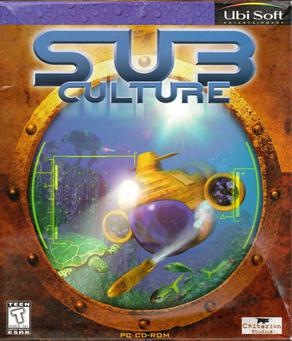
A submarine is a watercraft capable of independent operation underwater. It differs from a submersible, which has more limited underwater capability. The term is also sometimes used historically or colloquially to refer to remotely operated vehicles and robots, as well as medium-sized or smaller vessels, such as the midget submarine and the wet sub. Submarines are referred to as boats rather than ships irrespective of their size.

A modern torpedo is an underwater ranged weapon launched above or below the water surface, self-propelled towards a target, and with an explosive warhead designed to detonate either on contact with or in proximity to the target. Historically, such a device was called an automotive, automobile, locomotive, or fish torpedo; colloquially a fish. The term torpedo originally applied to a variety of devices, most of which would today be called mines. From about 1900, torpedo has been used strictly to designate a self-propelled underwater explosive device.
The Star Trek fictional universe contains a variety of weapons, ranging from missiles to melee. The Star Trek franchise consists mainly of several multi-season television shows and a dozen movies, as well as various video games and inspired merchandise. Many aspects of the Star Trek universe impact modern popular culture, especially its fictitious terminology and the concept of weaponry on spacecraft. The franchise has had a widespread influence on its audiences from the late 20th to early 21st century. Notably, Star Trek's science fiction concepts have been studied by real scientists; NASA described it in relation to the real world as "entertaining combination of real science, imaginary science gathered from lots of earlier stories, and stuff the writers make up week-by-week to give each new episode novelty." For example, NASA noted that the Star Trek "phasers" were a fictional extrapolation of real-life lasers, and compared them to real-life microwave based weapons that have a stunning effect.

The Marathon Trilogy is a science fiction first-person shooter video game series from Bungie, originally released for the Classic Mac OS. The name of the series is derived from the giant interstellar colony ship that provides the main setting for the first game; the ship is constructed out of the Martian moon Deimos. The series is often regarded as a spiritual predecessor of Bungie's Halo series.
I-52, code-named Momi was a Type C3 cargo submarine of the Imperial Japanese Navy used during World War II for a secret mission to Lorient, France, then occupied by Germany, during which she was sunk.
In video games, a power-up is an object that adds temporary benefits or extra abilities to the player character as a game mechanic. This is in contrast to an item, which may or may not have a permanent benefit that can be used at any time chosen by the player. Although often collected directly through touch, power-ups can sometimes only be gained by collecting several related items, such as the floating letters of the word 'EXTEND' in Bubble Bobble. Well known examples of power-ups that have entered popular culture include the power pellets from Pac-Man and the Super Mushroom from Super Mario Bros., which ranked first in UGO Networks' Top 11 Video Game Powerups.

Earth 2150: The Moon Project is a sequel to the real time strategy game Earth 2150. While the game is in fact a stand-alone game, many consider it an expansion pack because it does little more than provide new missions, and weapons. The story takes place alongside the original game's story. The Moon Project was released in 2000 by Strategic Simulations, Inc.
Air-independent propulsion (AIP), or air-independent power, is any marine propulsion technology that allows a non-nuclear submarine to operate without access to atmospheric oxygen. AIP can augment or replace the diesel-electric propulsion system of non-nuclear vessels.

Space Dungeon is a multidirectional shooter released as an arcade video game by Taito in 1981. Designed and programmed by Rex Battenberg, it was available both as a conversion kit and full arcade cabinet. An Atari 5200 port was published in 1983.
The history of the submarine goes back to antiquity. Humanity has employed a variety of methods to travel underwater for exploration, recreation, research and significantly, warfare. While early attempts, such as those by Alexander the Great, were rudimentary, the advent of new propulsion systems, fuels, and sonar, propelled an increase in submarine technology. The introduction of the diesel engine, then the nuclear submarine, saw great expansion in submarine use – and specifically military use – during World War I, World War II, and the Cold War. The Second World War use of the U-Boat by the Kriegsmarine against the Royal Navy and commercial shipping, and the Cold War's use of submarines by the United States and Russia, helped solidify the submarine's place in popular culture. The latter conflicts also saw an increasing role for the military submarine as a tool of subterfuge, hidden warfare, and nuclear deterrent. The military use of submarines continues to this day, predominantly by North Korea, China, the United States and Russia.

Advanced Dungeons & Dragons: Treasure of Tarmin is a video game for the Intellivision video game console and the Mattel Aquarius computer system. This game was a licensed Dungeons & Dragons adaptation. It is a successor game to Advanced Dungeons & Dragons: Cloudy Mountain (1982).

Monster Hunter Freedom is an action role-playing video game developed and published by Capcom for the PlayStation Portable. The first handheld installment in the Monster Hunter franchise, the game is an enhanced port of Monster Hunter G, rebalanced to allow for easier solo quest completion and game progression.
AquaNox is a series of submarine-based first-person shooter/simulation video games set in the distant future. The collection includes AquaNox, AquaNox 2: Revelation and AquaNox: The Angel's Tears. The predecessor and the starter of the series is the MS-DOS title Archimedean Dynasty.

Sub Culture is a submarine action/adventure computer game, developed by Criterion Games and published by Ubi Soft. It was released in 1997, and was often praised as a solid title, but received little recognition and had only limited sales. A spiritual successor, also developed by Criterion and published by Ubi Soft, was released in 2000 under the name Deep Fighter.
In pen and paper games and computer and video games, an item is an object within the game world that can be collected by a player or, occasionally, a non-player character. These items are sometimes called pick-ups.

Mega Shark Versus Giant Octopus is a 2009 American-British monster disaster film distributed by The Asylum, released on May 19, 2009, in the United States and on August 7, 2009, in the United Kingdom. It was directed by Ace Hannah and stars singer Deborah Gibson and actor Lorenzo Lamas. The film is about the hunt for two prehistoric sea-monsters causing mayhem and carnage at sea, and is the first installment in the Mega Shark series of films.

Seaquest is an Atari 2600 video game designed by Steve Cartwright and published by Activision in 1983. The game is an underwater shooter in which the player controls a submarine.
Lego Atlantis was a product range of the construction toy Lego, themed around the underwater world of Atlantis. The range was launched in early 2010 and discontinued by the end of 2011. The toy sets included models of buildable underwater vehicles, as well as "heroic diver" and "shark warrior" minifigures. A ride based on the range was operated at Legoland Windsor Resort.

Submarine Commander is a simulation video game for Atari 8-bit computers written by Dean Lock and published by Thorn EMI Computer Software in 1982. A VIC-20 port by Gary York was released in 1983 and an Apple II version by Patrick Buckland the same year. The Atari version was re-released in 1985 on cassette on the Sparklers budget label. A version for the TI-99/4A was announced but was not released until 1986 when a third party bought the rights.

Xenocide is a scrolling shooter for the Apple IIGS written by Pangea Software and published by Micro Revelations in 1989. An IBM PC compatible port using VGA graphics was developed by Manley & Associates and published in 1990. The box cover credits Brian Greenstone as the game's creator on both versions. Xenocide was the first commercially published game from Greenstone's company, Panega Software.











